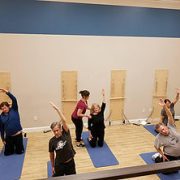6 Tips for Managing Debilitating Vertigo at Work
“Vertigo” is the sudden onset of dizziness, spinning and nausea that often stops you in your tracks without any visible signs or warning. If you’ve ever experienced vertigo, then you know the debilitating effects it can have on your daily life and ability to work. For those that haven’t experienced vertigo – it can be difficult to explain. Your co-worker will never understand why you missed that deadline. Your boss won’t understand why you had to miss work for the past three days. All because for 72 hours, the room has been spinning on and off, and you couldn’t spend more than five minutes reading on your computer before you felt the vertigo coming back on.
Perhaps the most challenging aspect of suffering from vertigo is the unknown. By definition, vertigo is a symptom that occurs due to a miscommunication between your vestibular system (responsible for balance and spatial orientation) and your brain’s interpretation of those signals. When the signals are mismatched – the result is vertigo – that awful, uncontrollable sensation of spinning or dizziness.
What does this look like in real life?
You could turn your head slightly too far or slightly too fast and bam – here comes the dizziness. You could get up from a chair or out of bed too quickly and suddenly the room is spinning. Vertigo has the ability to quickly and without notice turn the ordinary, mundane parts of your day into the scariest parts of your day… Suddenly everything from driving, working at a computer, walking to lunch, or getting up to go to the bathroom become debilitating and unreliable. Every single one of these tasks not only becomes difficult – but often the scariest parts of your day as well. becomes the scariest part of your day. Why? Because every single one of these tasks requires balance and coordination – and when your vestibular system and brain don’t cooperate – these things become extraordinarily difficult.
While there are many underlying causes to vertigo, and only a vertigo specialist can determine this, there are some things you can do to mitigate the onset of vertigo so that it doesn’t continue to impact your work day.
Here are tips for managing debilitation vertigo at work:
1. Utilize Blue Light Filter Glasses
Prolonged screen time can exacerbate vertigo symptoms, and these glasses work to block harmful blue light emitted by digital devices. By alleviating the eye strain associated with screen time, these specialized glasses create a more comfortable visual experience, potentially lessening the likelihood of triggering or worsening vertigo episodes during your work day – especially if your work involves extended use of the computer.
2. Wear Noise-Canceling Headphones
Noise sensitivity often accompanies vertigo. Using noise-canceling headphones can create a quieter work environment for you, minimizing any overstimulation that might trigger or worsen your vertigo episodes. When you reduce auditory input, you’ll find it easier to focus, and it will be a calmer sensory experience for you at work.
3. Opt for a Swiveling Computer Chair
A swiveling chair offers the flexibility to rotate your body when shifting between screens or tasks. This minimizes abrupt head movements, which can trigger vertigo. The ability to turn your body rather than constantly turning your head can significantly reduce the risk of a debilitating vertigo episode happening during your work hours.
4. Find a Stable Focus Point During Physical Activities
Engaging in physical tasks that might induce dizziness can be challenging. If you experience vertigo during physical movements, find a stable object or point in your surroundings and focus on it. This fixed reference point can help recalibrate your balance and reduce the sensation of dizziness.
5. Be Mindful or your Movement and Pace
Sudden and quick movements are known to trigger episodes of dizziness and spinning from those suffering from vertigo. When you mindfully and purposefully slow down – you alleviate the stress on your vestibular system. This can go a long way in helping to minimize triggers that may exacerbate your vertigo symptoms.
6. Ensure Adequate Lighting
Aside from your vestibular system, your vision also helps significantly with balance. By ensuring ample lighting in the workspace – you can help compensate for the disruptions caused by vertigo. Well-lit environments provide clearer visual cues, assisting in maintaining balance and reducing the risk of falls during a vertigo episode.
If you’re currently suffering from vertigo – or have been dealing with vertigo on and off for years – perhaps it’s time to consult with a physical therapy vertigo specialist. The right practitioner will perform specialized tests to identify if your root cause is movement based – and can determine if you need to see a neurologist or eye specialist instead or in conjunction. By going this route first, you can determine if the cause of vertigo can be successfully treated naturally , and avoid treatment approaches that involve medications or procedures that you might not need. But in the meantime, hopefully some of these strategies help you create a more manageable work environment if you suffer from vertigo on a regular basis.
Dr. Carrie Jose, Physical Therapist and Pilates expert, owns CJ Physical Therapy & Pilates in Portsmouth and writes for Seacoast Media Group. To get in touch, or seat in her upcoming Masterclass for Vertigo Sufferers – visit www.cjphysicaltherapy.com – or call 603-380-7902










